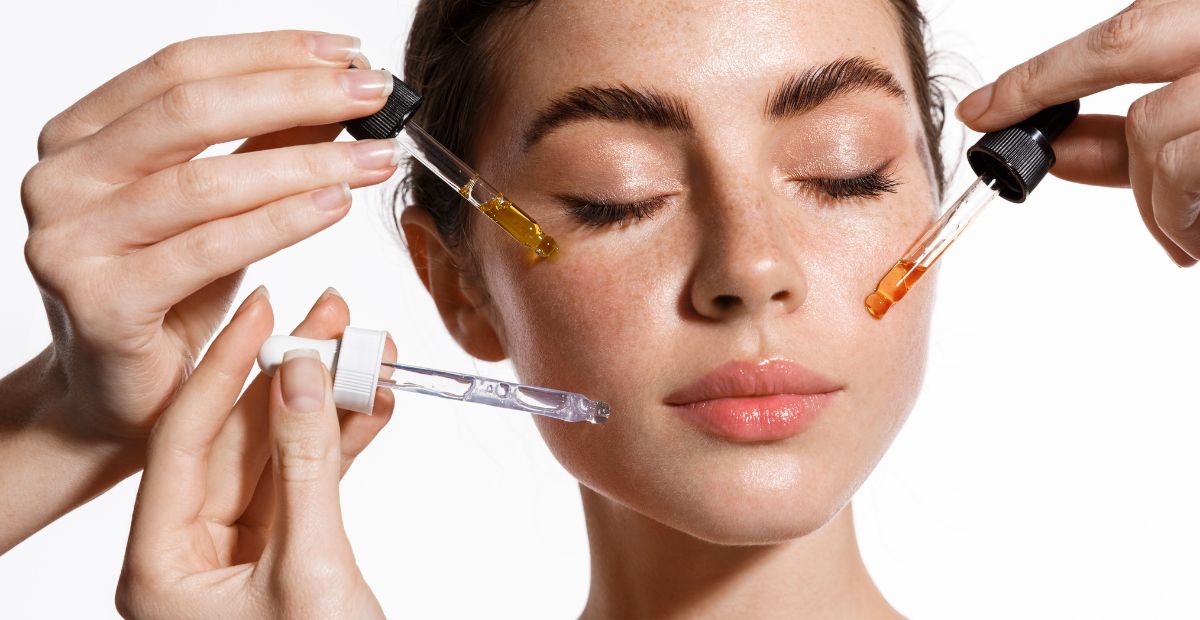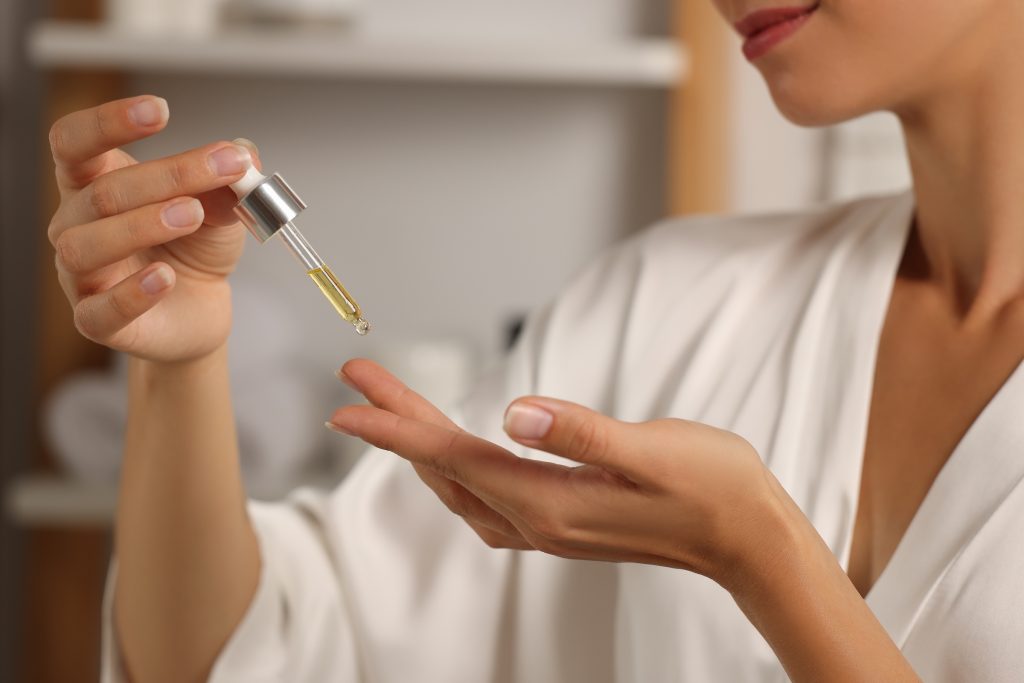How to Use Serum like a Pro: Everything You Need to Know
Onskin Content Team
Your guides through the skincare chaos

Face serums are like the espresso shot of skin care—small, powerful, and absolutely essential. Wondering how to unlock their full potential? Here’s everything you need to know on how to use serum without wasting a drop. Let’s get started.
What is a Face Serum?
To begin with, what is a face serum? Well, it’s a lightweight, potent liquid, designed to tackle your skin’s most stubborn problems—whether that’s acne, dryness, or the appearance of first fine lines.
Each small-but-mighty bottle is loaded with an active ingredient like vitamin C, hyaluronic acid, or retinol. Their concentration per bottle is so high that it only takes 2-3 drops of serum to do the job (seriously, that’s all you need).

Compared to moisturizers, serums penetrate deeper into your skin—thanks to their light texture and concentrated dose of actives. But is serum good for your face in the same way as your face cream? Can it replace your moisturizer?
Not quite! Although face serums provide some moisturizing benefits, it’s better not to rely on them as your primary source of hydration, particularly if your skin tends to be dry. Still, if you have oily skin, you may be fine with only using a hydrating serum (but it’ll hardly work for cold weather.)
What Does Serum Do for Your Face?

Now for the million-dollar question: what does a serum do for your face? Not all serums are created the same, and each has its own superpower. So if you’re asking yourself, what serums should I use, here’s the lowdown on what they can do:
Hydrate your skin and boost moisture levels. Packed with hyaluronic acid, hydrating serums lock in moisture, keeping your skin plump and juicy.
Brighten your complexion. Look for vitamin C serums that fight dark spots, hyperpigmentation, and dullness, making your skin look lit from within.
Target fine lines and wrinkles. Anti-aging serums usually come with retinol and peptides. They can smooth out fine lines and promote collagen production. (Before adding retinol to your routine, start with this complete guide on retinol and its siblings.)
Calm acne and redness. Ingredients like niacinamide or salicylic acid help balance oil, unclog pores, and soothe irritated skin.
Shield from environmental damage. Antioxidant serums (think vitamin E or green tea) protect your skin from pollution and UV stress.
Asking yourself what serum should I use is all about matching your goals with the right ingredients. You can also layer various types of serums to address different skin concerns—just make sure to apply the lightest one first. And use apps like OnSkin to check if those candidates perfectly suit your skin type.
When to Begin
As for when to apply serum for the first time, it actually depends on your skin type (this article will help define yours) and specific concerns. Typically, many dermatologists recommend incorporating a serum into your skincare regimen from around age 25. This is the time when the initial signs of aging, such as fine lines or a lack of glow, may start to appear.
How to Apply Face Serum Correctly

Okay, now for the juicy part: how to use serum the right way. This is where the magic occurs, but it’s also where people make the most mistakes. So let’s get the technique locked down.
Step 1: Cleanse your face. Always start with a squeaky-clean face. Your serum needs a fresh canvas to work its magic. Use a gentle cleanser that won’t deplete your skin’s moisture.
Step 2: Apply toner. Toner balances your skin’s pH and dampens it, which helps serums absorb better. Spritz it on or swipe it with a cotton pad—either works.
Step 3: Use serum. Here’s the golden rule: less is more. Apply 2-3 drops of serum to cover your entire face. Overusing it can irritate your skin or make it sticky. Apply the serum to your fingertips, then gently pat it into your skin. No rubbing, no tugging—just press it in like you’re giving your skin a mini hug. Be sure to apply it to your entire face, neck, and chest areas as well. They all need love!

Step 4: Follow with moisturizer. Once your serum is fully absorbed (give it 30 seconds), lock it in with a moisturizer. This helps to lock in the active ingredients and provides added hydration. Also, don’t forget about eye care: rely on this guide to apply eye cream like a pro.
Step 5: Add sunscreen (if it’s morning). Serums with acids, retinol, and other active ingredients can make your skin more sensitive to sunlight, so sunscreen isn’t just a nice-to-have—it’s a must. Luckily, many sunscreens now include hydrating or calming ingredients, so you may not even need a moisturizer underneath. Just pick one with at least SPF 30, and you’re good to go! But avoid these popular sunscreen mistakes.
When and How Often to Apply Serum
Most serums are used once or twice daily, but always check the label. Some ingredients, like retinol, are better used sparingly to avoid irritation.
What about time of the day? Use vitamin C serums for your morning routine—to protect against daily environmental damage. And always finish with sunscreen. Retinol and exfoliating serums work best at night, as they can increase your skin’s sensitivity to sunlight.
5 Mistakes When Using Serum

Last but not least, it’s about how to use serum without causing more harm than good. Even seasoned skincare lovers mess this up sometimes, so here’s what NOT to do:
1. Skipping patch tests. Always patch test new serums, especially those with potent ingredients like retinol or vitamin C. Apply a small amount on your wrist or neck and wait 24 hours for any reaction.
2. Applying too much. Using too much serum doesn’t give you more benefits; it just wastes product. Stick to 2-3 drops and spread it evenly.
3. Rubbing instead of patting. Rubbing serum into your skin wastes product and can irritate your face. Instead, gently press it in with your fingertips for better absorption.
4. Using it at the wrong time. Some serums are day-specific (like vitamin C), while others (like retinol) are better for nighttime. Pay attention to the label.
5. Ignoring signs of irritation. If your skin feels red, itchy, or dry, take a step back. You might need to use the serum less frequently or swap it for a gentler formula.
Glow-Up Time
So there you have it: your crash course on how to use face serum like a pro. Whether you’re targeting breakouts, chasing that dewy glow, or simply protecting your skin for the long haul, serums are an absolute must-have. But remember, skincare isn’t about perfection; it’s about being consistent and tuning into your skin’s needs.
The next time you pick up that cute little bottle, you’ll know exactly what to do. With just a few drops, patience, and the right technique, your skin will look like pure art afterwards.
FAQ
-
Where do I start with OnSkin?
Download the app and think of a product you’d like to know more about. Then, go to the main screen and choose how you’d like to get the info —by manually looking it up in the search bar, by scanning its barcode, or by simply taking a picture of the packaging. Once you’ve done any of these, you can see how safe the product is and if it suits your skin or hair (if this analysis is available).
-
What is Safety Rating, and how is it calculated?
In OnSkin, we base product rates on ingredients. Each is closely studied by our medical team and then evaluated. This way, each product gets a score from 0 to 100, with 100 as the safest level.
Safety Levels
- Excellent (76–100)
- Good (51–75)
- Not great (26–50)
- Bad (0–25)
These scores are backed by the latest scientific studies. You can find links to the resources we’ve used on each ingredient page. To assess the safety of product ingredients, we evaluate them according to the following parameters/criteria
- Endocrine disruption risk / Reproductive toxicity
Indicates the probability of mimicking, blocking, or interfering with the body hormones.
- Сarcinogenicity
Measures the potential risk of inducing cancer.
- Allergy risk
Estimates the probability of an allergic reaction.
- High concentration alert
Determines the risk of being unsafe in certain amounts.
-
What is Skin Match?
Based on the info you input about your skin type, age, skin care goal, and other “settings,” OnSkin checks how well a product is tailored to your unique skin needs — it’s basically like a dermatologist helping you find the right products, minus the fees and the long wait. The product you’re checking might be labeled as It’s a match!, Hit-or-miss, or Not a match for you. The app also detects ingredient groups such as Anti-acne, Anti-inflammatory, Moisturizes, May be drying, Comedogenic, and others — by tapping one, you see exactly what ingredients from this or that group are in the product.
-
I seem to have a problem with using the app. Who should I contact?
Please reach out to us at [email protected], and we’ll carefully look into your issue. Your ideas for improving the app are also very welcome!
-
Do you have an Android version?
Not yet! Hey Android users, we hear you, and we're thinking about making an Android version, but we haven't started the development yet.
Tracker Sent!
It’s on the way to your inbox.




